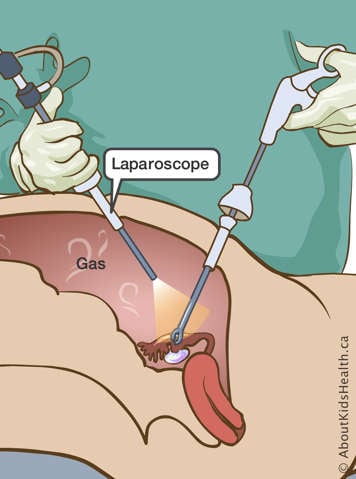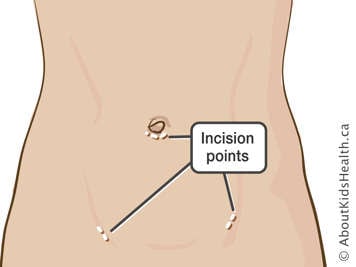
What is laparoscopic surgery?
Laparoscopic (lap-uh-ra-SCOP-ic) surgery is a way to perform operations using only very small incisions (cuts) into the skin. This type of surgery uses a thin rod-shaped instrument with a tiny camera on the tip, called a laparoscope. The laparoscope is put into the body and moved from the outside by the surgeon. The camera sends pictures to a TV monitor or other viewing device. During the operation, the surgeon can see the organs inside the body on the viewing device.
Because this modern surgical technique does not require opening up the body as much as traditional open surgery does, medical people call laparoscopy minimally invasive surgery.
Laparoscopy is used for many different types of surgery on the abdomen and pelvis. Depending on the type and reasons for the surgery, the laparoscopy may take several hours.
There are different reasons to perform laparoscopy
There are different types of laparoscopy:
- Laparoscopy to find out the cause of a problem like pain, or to provide more information after other tests are done, is called diagnostic laparoscopy.
- Laparoscopy to treat a problem is called operative laparoscopy. Sometimes if a problem is found at a diagnostic laparoscopy then it can be fixed at the same time. This means we only need to do one operation, not two.
In gynaecology, laparoscopy is done for the following reasons:
- treating ovarian cysts
- removing some ovarian masses
- diagnosing and treating ovarian torsion (twisting)
- evaluating chronic pelvic pain
- diagnosing and treating endometriosis
- evaluating infertility
- treating some ectopic pregnancies
Laparoscopy is not for everyone or for every situation
There are many other reasons laparoscopy might be performed. However, laparoscopy is not always right for everyone. It cannot always be done for every type of condition requiring surgery.
Your doctor will discuss with you why laparoscopy is right or not for your child's condition.
All surgeries have some risk
All surgeries have risks from infection, bleeding, the anesthetic and other problems. All steps are taken to reduce these risks.
Sometimes, though very rarely, organs and structures in the body can be injured during a laparoscopic surgery. The risk of injuring these organs is less than 1%. If this rare situation occurs, the surgeon can usually repair the damage right away. Sometimes, if there is an injury, the little incisions have to be converted to a bigger incision so the surgeon can get a better look at the injury and fix it. This is extremely rare.
During a laparoscopic surgery
Like traditional open surgery, laparoscopy is done in the hospital. Your child will be prepared for surgery and will probably have to stop eating and drinking several hours before the procedure begins.
During the procedure, your child will be put to sleep with a special "sleep medicine" called general anesthetic. This helps make sure that your child will sleep through the procedure and will feel no pain.
Your child's abdomen (belly) is filled with carbon dioxide gas (CO2). This lifts the abdominal wall like a dome. It gives the surgeon a better view of the organs inside the body, like the uterus, ovaries and bladder. It also gives the surgeon more space to work inside the body.

The surgeon makes a 1 cm incision (about half an inch) near the belly button for the laparoscope. Then the surgeon makes small 5 mm incisions (about a quarter inch each) in the lower corners of the abdomen. These incisions are for any other instruments that might be needed.
The number and exact location of the incisions depends on which type of surgery is being performed. If different incisions are being used, your doctor will tell you ahead of time.
After the operation is finished, all the instruments are removed. The CO2 gas is removed from inside the body. Any remaining CO2 is absorbed and naturally processed by the blood. The surgeon closes the incisions with dissolving stitches and/or steristrips. Steristrips are little sticky tapes used to help hold together and protect the healing skin.
After the laparoscopic surgery
Children usually recover faster from laparoscopic surgery than from traditional open surgery. Many patients go home the same day as the surgery. Because of the smaller incisions, scars are very small compared to traditional surgery.
Many children return to school after a few days.
Depending on the surgery, your child may take a little longer to return to all of their usual physical activities, such as contact sports. Ask your doctor what activities your child can and cannot do in the days and weeks after the surgery.
Managing pain after the operation
Children usually have less pain after laparoscopic surgery than after traditional open surgery. If there is pain after the surgery, your child's doctor may prescribe a pain medication. Or, the doctor may suggest your child take a non-prescription pain medication such as ibuprofen.
Your child's shoulders might be sore as the remaining CO2 gas from the operation is re-absorbed into the body. The gas can irritate the diaphragm, which is a muscle in the abdomen. Because the diaphragm muscle shares nerves with the shoulders, some children have sore shoulders after the surgery.
Following up after the operation
Your child will see the doctor again about six weeks after the surgery to discuss the operation and find out how your child is now doing.
If the doctor wants to see you sooner, he will let you know
If you have questions about the surgery, make a list to ask your doctor.